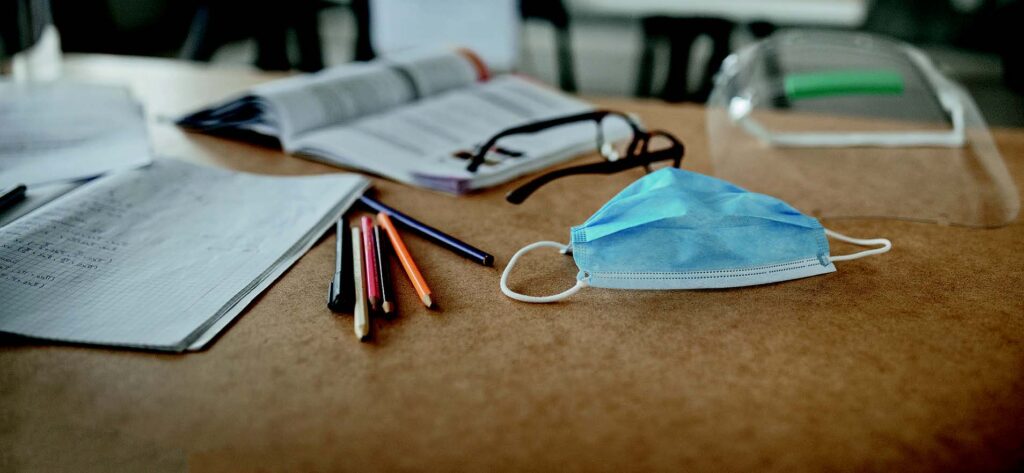Rounding up the Latest Updates and Information on COVID-19
“Following the return of schools after the Winter break, all previous risk assessments require to be revisited, including individual risk assessments for staff who are at greater risk.”
Throughout the pandemic, the EIS has continued to press for appropriate mitigations in schools, colleges and universities to protect staff and students. Here, we round up the latest information and advice for members.
Self-isolation
As members will be aware, significant changes to Covid guidelines were announced by the Scottish Government over the Festive period. These were unilateral decisions by Government, without discussion, directly or within CERG (Covid Education Recovery Group), with the EIS regarding the potential impact on educational establishments.
It remains to be seen as to whether the changes to self-isolation rules, both for those infected and for close contacts, have served to improve or worsen the situation.
The EIS has asked for access to the scientific data on the risk associated with reducing 10 days, for positive cases, to 7 (with 2 clear lateral flow tests on Day 6 and 7). First Minister Nicola Sturgeon said it was a “judgment” call which means it could lead, potentially, to increasing infection levels in a school and therefore be counterproductive regarding staffing availability.
Members have raised concerns around the efficacy of a pupil/parent controlled close contact regime of 7 lateral flow tests to avoid self-isolation. We have asked the question of the Scottish Government, that if these tests are to be reported over 7 days, who are they reported to and how is the situation monitored? We have also asked as to who supplies lateral flow tests for pupils and for further advice to be offered to schools on how this is all to be managed.
Mitigations
Following the return of schools after the Winter break, all previous risk assessments require to be revisited, including individual risk assessments for staff who are at greater risk. Support, if required, is always available in the risk assessment process from Local Associations and/or Area Officers and Organisers.
Ventilation remains key but Councils have a duty also to ensure that classrooms are warm enough, either through the provision of additional heating sources or higher system settings. Where either of these areas remains a concern, members should seek support from their school rep or Local Association Secretary to resolve matters.

Members are encouraged to make full use of lateral flow tests available to them and, also, where applicable, to get booster jags or first/second vaccinations doses.
The latest updated Scottish Government schools guidance, including self-isolation rules, can be found at: www.gov.scot/publications/coronavirus-covid-19-guidance-on-reducing-the-risks-in-schools
The EIS’s own guidance for Early Years, Primary, Secondary, Special Education
“Despite the broader societal relaxation of covid mitigations, the EIS has continued to argue for maximum caution in relation to schools and nurseries”

Primary, Special Education Secondary and IMTs has also been updated to reflect the relevant changes to the Scottish Government schools guidance. The updated guidance can be accessed via: www.eis.org.uk/Education-Advice/EducationRecovery
The EIS national survey, referenced elsewhere in this SEJ, evidences the huge effort teachers have made to support education continuity over the period of the pandemic. Recognition of that often seems scant but the EIS is very clear about the critical role of educators. Hopefully, 2022 will see the worst of the pandemic behind us.
SAGE update
The Covid Education Recovery Group recently received an update from the sub-group of SAGE which advises on education matters.
Despite the broader societal relaxation of covid mitigations, the EIS has continued to argue for maximum caution in relation to schools and nurseries, which remain working environments for staff. We have seen record levels of both pupil and staff covid related absences and despite some societal drops in the numbers, last week saw the figures for younger children shoot up again, after a previous drop.
Against this background, and the EIS having written directly to Linda Bauld, Chair of the sub-group, urging caution, it was agreed that no major changes in the school guidance would be enacted, and that current guidance on face coverings would be retained.
At the time of writing, it is anticipated that current guidance will remain in place up to the February break, at least. There was broad agreement at CERG, also, that going forward a phased approach to any changes would be beneficial.
F&HE Covid Update
The Scottish Government guidance in relation to COVID-19 in further and higher education institutions can be found at www.gov.scot/publications/coronavirus-covid-19-universities-colleges-and-community-learning-and-development-providers/
This advice is regularly updated in response to developments in the pandemic, including the rise in prevalence of the Omicron variant. All members are encouraged to familiarise themselves with the latest version of the guidance, its steering principles and the content of ministerial letters to institutions included within the documentation. Please inform your branch officials, or full-time officer, if you hold concerns regarding your institution’s plans for the new semester in relation to what is outlined in the Scottish Government Guidance.
Staff members in both colleges and universities are subject to the changes to self-isolation / contact procedures.
As in schools, EIS members in further and higher education continue to step up to the challenges of the pandemic. Please seek support from your branch, or the EIS centrally, if you have any concerns regarding COVID-19 mitigation at your institution.
